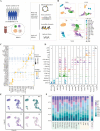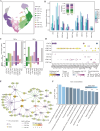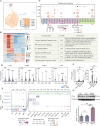Immunoregulatory programs in anti-N-methyl-D-aspartate receptor encephalitis identified by single-cell multi-omics analysis
- PMID: 39779473
- PMCID: PMC11710936
- DOI: 10.1002/ctm2.70173
Immunoregulatory programs in anti-N-methyl-D-aspartate receptor encephalitis identified by single-cell multi-omics analysis
Abstract
Background: Anti-N-methyl-D-aspartate receptor encephalitis (anti-NMDARE) is a prevalent type of autoimmune encephalitis caused by antibodies targeting the NMDAR's GluN1 subunit. While significant progress has been made in elucidating the pathophysiology of autoimmune diseases, the immunological mechanisms underlying anti-NMDARE remain elusive. This study aimed to characterize immune cell interactions and dysregulation in anti-NMDARE by leveraging single-cell multi-omics sequencing technologies.
Methods: Peripheral blood mononuclear cells (PBMCs) from patients in the acute phase of anti-NMDARE and healthy controls were sequenced using single-cell joint profiling of transcriptome and chromatin accessibility. Differential gene expression analysis, transcription factor activity profiling, and cell-cell communication modeling were performed to elucidate the immune mechanisms underlying the disease. In parallel, single-cell B cell receptor sequencing (scBCR-seq) and repertoire analysis were conducted to assess antigen-driven clonal expansion within the B cell population.
Results: The study revealed a significant clonal expansion of B cells, particularly plasma cells, in anti-NMDARE patients. The novel finding of type I interferon (IFN-I) pathway activation suggests a regulatory mechanism that may drive this expansion and enhance antibody secretion. Additionally, activation of Toll-like receptor 2 (TLR2) in myeloid cells was noted, which may connect to tumor necrosis factor-alpha (TNF-α) secretion. This cytokine may contribute to the activation of B and T cells, thereby perpetuating immune dysregulation.
Conclusions: This study presents a comprehensive single-cell multi-omics characterization of immune dysregulation in anti-NMDARE, highlighting the expansion of B cell and the activation of the IFN-I and TLR2 pathways. These findings provide deeper insights into the molecular mechanism driving the pathogenesis of anti-NMDARE and offer promising targets for future therapeutic intervention.
Key points: Significant B cell clonal expansion, particularly in plasma cells, driven by antigen recognition. IFN-I pathway activation in plasma cells boosts their antibody production and potentially exacerbates immune dysregulation. TLR2 pathway activation in myeloid cells contributes to TNF-α secretion and could influence adaptive immune responses.
Keywords: anti‐N‐methyl‐D‐aspartate receptor encephalitis; autoimmune disease; regulatory program; single‐cell multi‐omics sequencing.
© 2025 The Author(s). Clinical and Translational Medicine published by John Wiley & Sons Australia, Ltd on behalf of Shanghai Institute of Clinical Bioinformatics.
Conflict of interest statement
The authors declare they have no conflicts of interest.
Figures





References
MeSH terms
Grants and funding
- 2021YFA1102100/National Key R&D Program of China
- 32070644/National Natural Science Foundation of China
- 32470648/National Natural Science Foundation of China
- 32293190/National Natural Science Foundation of China
- 32293191/National Natural Science Foundation of China
- 82371354/National Natural Science Foundation of China
- 82071343/National Natural Science Foundation of China
- 2023B03J1347/Guangzhou Key Research and Development Program
- 2024A1515011285/Natural Science Foundation of Guangdong
- 2022A1515110223/Guangdong Basic and Applied Basic Research Foundation
- 22qntd2621/Fundamental Research Funds for the Central Universities, Sun Yat-sen University
LinkOut - more resources
Full Text Sources
